 |
Luong Quang Huy describes a participatory research approach designed to empower local communities in adapting to socio-economic trends and climate change. |
| The project resulted in a framework that encouraged local communities to use reflexively what they already have, such as their knowledge and connections, and to apply critical thinking on a daily basis. The most significant aspect proved to be the capacity to establish networks to make the best of available resources, not only to reduce vulnerability to long-term change, but also to improve social coherence and living standards in the present-day. | |
| The author is a member of the Department of Meteorology, Hydrology and Climate Change of the Vietnam Ministry of Natural Resources and Environment and the Standing Office of the Vietnam National Target Programme to Respond to Climate Change. | |
It was around lunch time on a day in late September 2005. Autumn was already around the corner but the midday heat, accompanied by strong wind from the open sea, made standing on the area next to the sea dyke in Giao Thuy district almost unbearable. Everything around myself and my colleagues seemed so quiet and peaceful, a day like any other summer day in this rural area in the north of Vietnam. It was almost impossible to believe, let alone to properly comprehend, that just a few days ago this area suffered from one of the worst natural disasters in the past 70 years in this area - the Damrey tropical storm.
Not far from where I was standing, a few men and women were working on their family rice field, trying to patch the damaged bank caused by the storm. Wiping the sweat on his forehead, Mr Nguyen Van Minh, a typical rice farmer and a father of four, looked up at us without the slightest curiosity when we approached him, and asked: "You reporters come here to write about the storm?"
"No, we are researchers," we answered, "but we do want to learn of what happened to your family and people in the district."
"Oh, right," he replied, with what seemed to be no surprise at all from his facial expression. "What are you researching this time?"
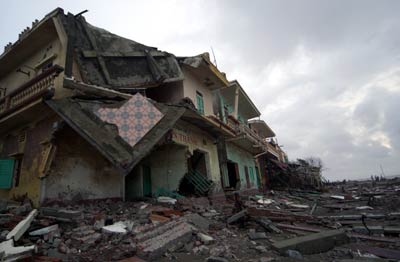 |
|
Storm damage caused by Typhoon Damrey, Giao Thuy
district, Vietnam
© Luong Quang Huy |
"Well, we'd like to know how you respond and cope with disasters, like that Storm No.7," we answered, trying to make conversation, " - how is your family coping?"
"We just wish we could have other work to earn more money, then we would not have to rely on this rice field, and lose almost all of it after a storm like this", he replied, and rather gave us the signal "Do not disturb" by turning back to his work on the rice field bank. But just before we left, he said, "Those shrimp farmers out there," pointing to the shrimp farming area behind the sea dyke, "lost more than us but they are still alright."
And that was the end of our brief conversation with Mr Nguyen Van Minh, a local farmer who mostly works on his rice field and family livestock but sometimes travels to Hanoi to work as a construction worker between the rice seasons.
| Typhoon Damrey |
|---|
|
Typhoon Damrey, known as Storm No.7 (2005) in Vietnam, struck northern Vietnam on September 27th 2005, affecting coastal provinces from Quang Ninh to Da Nang. The following day, heavy rains and wind triggered mudslides and flooding in the provinces of Yen Bai, Lao Cai and Phu Tho. Thousands of people were left homeless and many lost their means of income and subsistence as rice fields, ponds and farms were left damaged. |
The last thing that Mr Nguyen Van Minh said to us was difficult to understand. How could shrimp farmers, who lost most, or even all, of their investment on the shrimp farm that year be "still alright", as Mr Nguyen Van Minh put it? There seemed to be a touch of envy, perhaps resentment, in Mr Nguyen Van Minh's voice when he referred to them.
Moving beyond the sea dyke to the shrimp farming area, we met Mr Tran Tuan Anh, a shrimp farm owner, who was supervising his workers. These workers, we later learnt, were local rice farmers hired for a few days to help deal with the storm damage to his shrimp farm.
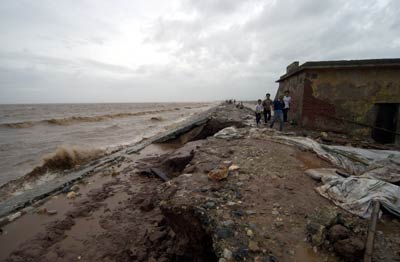 |
|
Storm damage to coastal defences caused by Typhoon
Damrey, Giao Thuy district, Vietnam
© Luong Quang Huy |
We asked him about his loss caused by the Damrey. "Yeah! My family lost quite a lot, most of our investment this year, but it should be OK, we can reinvest with help from our extended family and other shrimp farmers - it will be quite a bit of investment for the next season, but it should be OK," he answered, with a calmness and confidence that we did not find in Mr Nguyen Van Minh.
This brief visit to a coastal district in the north of Vietnam was undertaken during pilot work for the research project that formed the basis of a postgraduate thesis undertaken in the Climatic Research Unit at the University of East Anglia in the United Kingdom. It had already raised many questions regarding coping and adaptive capacity at the local level in environment-dependent, developing communities - about the need for livelihood diversification and how that requirement could be met, about differential abilities to cope within a community, about why some people can meet disaster with confidence and others not, about how inequity can erode solidarity within a community and, last but not least, about the responsibility of the researcher when interacting with local people in the aftermath of disaster.
The starting point for the research was the concern that local knowledge and understanding, a vitally important element of social, economic and political lives in any given community, has historically been undervalued and underused in climate vulnerability and adaptation research. As local knowledge evolves constantly in response to changing conditions, it has in itself a high level of adaptive capacity. Building on the inherent evolution of local knowledge to develop new expertise, understanding and applications may help local communities analyse and anticipate future changes, rather than simply observing events and responding to them as they occur. While climate studies often make use of local knowledge as input during the research process, participatory methods have tended to be information-extractive rather than -interactive. Is it possible to empower individuals and communities by developing local knowledge through greater engagement in the research process itself?
| Giao Thuy district |
|---|
|
Giao Thuy district is a coastal area, covering 16,300ha of Nam Dinh province. The population stood at approximately 212,000 by the end of 2007, with a steady growth rate of 1.4 to 1.5 per cent over the previous decade or so. The district is located in one of the fastest developing economic zones in Vietnam and local livelihoods are relatively diverse. Rice cultivation remains the main economic activity, but, as a result of the economic renovation process of doi moi, aquaculture, fishing, salt making, sea-food processing and other trading and services related to the agricultural and aquacultural sectors now supplement the incomes of many households. In what remains a predominantly agricultural community, the development of economic groups whose livelihoods are largely independent of the environment, such as traders, now contributes significantly to the local economy and assists a large number of households to diversify their livelihoods. Nevertheless, a large part of the district's population remains poor, income inequality is increasing and the majority of the population is highly dependent on the environment. |
The research was based on fieldwork in the case study area, Giao Thuy district, and made use of surveys, interviews, focus groups, participatory methods, scenario development and statistical analysis. The approach to vulnerability drew on the author's involvement in research projects in the Red River Delta of northern Vietnam conducted by the University of East Anglia and the Centre for Environment Research Education and Development in Hanoi. An initial assessment resulted in a framework of differential vulnerability amongst the livelihood groups within the community, which was used as a basis for subsequent analyses. A scenario development approach was then used to engage the local community in the research process over a prolonged period, considering their current socio-economic and environmental circumstances and possible futures, explored through reflection regarding personal livelihoods and community prospects and aspirations. The process, which was conducted over a one-year period, was designed to develop local knowledge and understanding and to share perceptions between groups within the community. Towards the end, local participants were questioned about the impact of engagement in the research process on levels of confidence, perceptions of empowerment and other benefits.
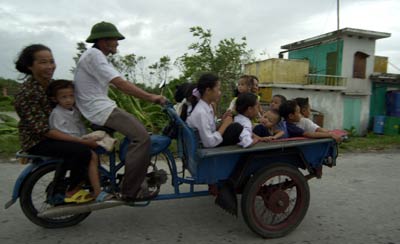 |
|
Fleeing Typhoon Damrey, Giao Thuy district, Vietnam
© Luong Quang Huy |
The vulnerability analysis confirmed that the process of economic renovation has significantly affected the development of Giao Thuy district. While the community has become wealthier overall, income inequality increased sharply during the early years of the present century. Vulnerability is also being affected, adversely in many circumstances, by changes in market policies and the dismantling of agricultural cooperatives. Analyses of income disparity and other factors affecting local vulnerability identified four major groups in the community: agriculture; aquaculture; trading and services; and manufacturing, construction and industry. The former two are termed the environment-dependent groups and the latter two environment-independent.
The identification of these groups proved a critical finding of the research. The research compared and contrasted the situation of these groups and their perceptions in order to define how local knowledge and understanding may be cultivated further and the implications of this development. It emerged that the newly established, environment-independent groups are heavily reliant on community networks to sustain their livelihoods and, as a result, are enhancing their social capital, developing coping and adaptive capacity. Such networks are a major means by which local knowledge is shared. Members of these networks are seen as gaining certain advantages compared to those who are not actively involved. Networking, therefore, as a means of developing community knowledge and understanding became a principal focus of the research.
While all four economic groups showed a similar level of knowledge and understanding acquired over the years with regard to their immediate livelihoods and related climate and socio-economic conditions, the environment-independent groups have made use of a considerably wider range of information sources, facilitated by the networks that they developed as they diversified their livelihoods. This strengthened their ability to access, share and make effective use of knowledge and understanding and, therefore, of existing resources. It was widely accepted that the level of information and knowledge was not in itself the pivotal factor in building capacity to better cope with stress. The most important factor was the capacity to network in order to enhance social capital, obtain information, and most importantly, use such information and the social relationships to diversify economic activities, improve living standards and, thereby, cope with stress more effectively.
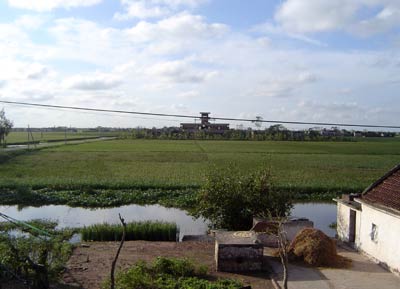 |
|
Rice field, Giao Thuy district, Vietnam
© Luong Quang Huy |
The agriculture group and, to a lesser extent, the aquaculture group remain relatively isolated in terms of access to information sources. They are reliant on sources close to their households and do not benefit from networking, in terms of widening access to information and ideas. The environment-independent groups have used their resources to improve substantially their situation and incomes, in particular, by expanding into lower risk economic activities, sharing contributions towards improvements in their households' livelihoods and cooperating with other groups to share possible risks. The environment-independent groups have developed a strong sense of the value of widening their knowledge base, an appreciation not previously manifested across the whole community. The activities developed by these groups contribute to lowering the level of exposure to risk among the community.
Community involvement in the development of a climate and socio-economic scenario for the medium-term future provided a means of addressing the possibility of empowerment by engaging the local community in the research process. It was found that the research process enabled the participant households to think critically and reflexively by analysing the implications of socio-economic and environmental developments in relation to their present and future lives, especially in terms of coping and adapting to stresses. Most importantly, it enabled them to acknowledge other groups' capacities and limitations in a comparative manner, thereby recognising what they could do to improve their own adaptive capacity. In particular, the environment-dependent groups recognised the advantages gained by the environment-independent groups in developing social networks through which information was shared and knowledge developed. The former acknowledged that they had the capacity to develop further their own networks.
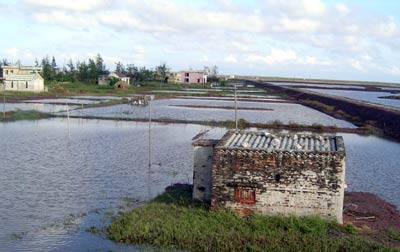 |
|
Shrimp farm, Giao Thuy district, Vietnam
© Luong Quang Huy |
A survey undertaken towards the end of the year-long fieldwork showed that a majority of individuals and households involved in the research acknowledged a significantly higher level of confidence, inspiration to take action and empowerment as a result of engagement in the research process. They expressed two important benefits of having engaged in the research process, namely recognition of the importance of social networks in coping and adaptation and improved capacity to cope with and adapt to climate impacts and socio-economic changes through increased understanding. A number of households and individuals had acted on the understanding gained during the scenario development process, not only by accessing further information and knowledge but also by setting up groups and networks based on common interests to tackle difficulties in diversifying economic activities and increasing preparedness to cope with climate impacts.
During the final stage of the research, a framework for initiating activities aimed at the establishment of social networks to support livelihood diversification and enhance coping and adaptive capacity was proposed by the participants, providing concrete evidence that the local community had recognised the importance and significance of the capacity to network and found ways of implementing this. A high percentage of individuals and households regarded the increase in empowerment they perceived had occurred as a result of engagement in the research process as highly effective in support of their capacity in to prepare for climate hazards and, in the longer-term, develop adaptation activities.
The most striking and significant achievement of the project has been a framework to encourage local communities to reflexively use what they already have, such as their knowledge and connections, and apply critical thinking on a daily basis. A critical aspect proved to be the capacity to establish networks to make the best of available resources, not only to reduce vulnerability to long-term change but also to improve to social coherence and living standards in the present-day. While this particular conclusion may be specific to the study area, it is hoped that the participatory research approach can be applied in other parts of Vietnam and, taking account of cultural differences, to other nations. It remains to be seen what the longer-term effects of involvement in the project will be, but the local people, through engaging in the research process, have by their own assessment been empowered to analyse critically their situation, recognise problems and propose solutions.
Acknowledgements
This research was supported by various organizations including the Global Change SysTem for Analysis, Research and Training (START), the International Foundation for Science (IFS) and the University of East Anglia, to whom grateful acknowledgement is given. I would also like to thank the people of Giao Thuy district for their invaluable cooperation and my research supervisors Mick Kelly and Irene Lorenzoni at the University of East Anglia and Nguyen Huu Ninh at the Centre for Environment Research Education and Development.
Further information
Luong Quang Huy, Standing Office of the National Target Programme to Respond to Climate Change, Department of Meteorology, Hydrology and Climate Change, Ministry of Natural Resources and Environment, #8 Phao Dai Lang Street, Dong Da District, Hanoi, Vietnam. Fax: +84-4-37759770. Email: huylq98@gmail.com. Web: www.monre.gov.vn